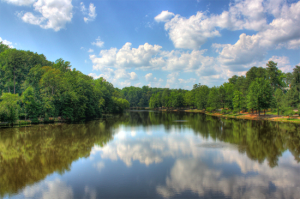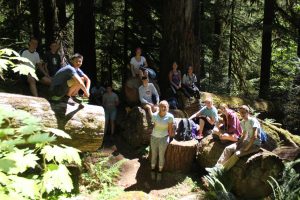Benedict Roemer (Synthesis 1)
Parks, both local municipal parks and national parks, can serve multiple purposes. They can serve to protect the environment which they encompass or they function as a gateway to the wilderness for the public. Generally parks perform this first action well because they block the land from being developed or otherwise turned into a source of pollution and destruction of natural habitats. However, the existence of parks as a gateway to the wilderness is sometimes not fully realized. It is important that parks fully serve this second purpose so that the public can actively participate in preserving and protecting nature even outside of the boundaries of designated park lands.
A public aware of a problem is a public capable of taking action to solve that problem. The important puzzle created by this equation is how to make a public aware of the problem that one is trying to solve? In the case of preserving natural habitats and our environment through reducing pollutants in the air and water or rebuilding healthy forests and riparian zones, public awareness can be created by showing the public what it is that needs to be saved, and why it is important that it is saved from destruction. Public parks, which are often areas of protected environments can serve as places to build public awareness. In William Cronon’s “The Trouble with Wilderness”, he speaks about the ways in which people have been inspired, or even terrified by the great wilderness. While Cronon criticizes a view of the wilderness as being pure, he acknowledges that “The striking power of the wild is that wonder in the face of it requires no act of will, but forces itself upon us—as an expression of the nonhuman world experienced through the lens of our cultural history—as proof that ours is not the only presence in the universe.” (p. 18) By realizing that we humans are not alone in this universe, we can appreciate the importance of protecting the continued existence of other animal and plant species in the universe, and specifically on our planet earth. As Cronon goes on to say, and as we also discussed in class, it is also important to recognize that natural environments do not have to exclusively exist in the wilderness, or parks. The connection to our local environments must be made to have to greatest impact on protecting that with which we share our planet.
The next step from awareness in preserving environments is appraisal. Donelson R. Forsyth has established an awareness-appraisal model for the ways in which humans react to problems with their environment. Parks can certainly help to raise the publics awareness about environmental issues as I discussed in the previous paragraph, but they can also play an important role in helping the public in the process of appraising the conditions of their local environments and watersheds. Many parks already have educational components, such as the work that the James River Park System does in educating children in Richmond through summer camps and other programs. However, this is a role that could become still more central to parks and also private holders of

Westhampton Lake on the campus of the University of Richmond. At times more than 50% of the lake is covered by algae blooms.
preserved lands and bodies of water. For example, the University of Richmond could do a much better job of informing their students and local members of the community about the pollutants find their way into the Little Westham Creek and Westhampton Lake. Through appraisal of the problems that lead to the algae blooms on Westhampton Lake, or the high sediment problem in the James River, behaviors can begin to change and the public will begin to work together to mitigate these problems.
The last step in Forsyth’s awareness-appraisal model is a change in behavior. When the public has reached an adequate level of awareness to properly appraise the situation, they can begin to change their behavior in order to solve the problem. This can be done through smaller personal gestures such as no longer using harmful fertilizers on your yard that will run off into the nearby stream before finding its way through each hierarchical level of the watershed in which you live. One can also change your own behavior as the behavior of your community adjusts to remedy the harm that has been done to the local environment. A strong sense of community is an important part of the awareness-appraisal model. While visiting Portland, Oregon, and reading Portlandness, I could see how a strong sense of community – even within a sizable city – had made a difference in establishing environmentalism as part of the city’s identity. Another example of community playing an essential role is seen in the creation and survival of the James River Park System. When funding was cut for the system, the community saw the importance of protecting the natural landmarks in and around Richmond and took action to keep the parks clean and open. Parks can and should continue to build community actions towards preserving natural environments. They can do this by serving as community centers where the public can come together in a place of nature to work together to preserve their local environments in their own neighborhoods. The James River Association, while not a
park, provides a good model for the ways in which parks could engage and grow the community. The River Rats program is a wonderful model of community engagement that even encourages members to not only continue to protect the James River, but also begin projects around environmental protection in their own, more local community which can further expand awareness to others. Alone or as a community, awareness and appraisal will lead to a change in behavior and action towards protecting the environment, and parks can take an active role in encouraging action through bringing community together and showing them how they can best go about taking action.
Parks play an essential role in building awareness of the importance of preserving natural habitats and ecosystems, but their role in environmental protection does not have to end there. Parks can also take on a very important role in the next two steps of Donelson Forsyth’s awareness-appraisal model. Parks and other organizations such as universities can help the public to appraise exactly what are the pollutants affecting the environment and how to live in such a way that fewer pollutants will find their way into the environment. All that’s left then is to change behaviors so that fewer pollutants are used and less harmful developments are built. Once again, parks can help individuals and communities to take action. I think that this is the step that is most often missed. For example, the HJ Andrews Experimental Forest is not a public park like Shenandoah or the James River Park System are,
but the trails and forests are open to the public. However, in our time there, I saw very few members of the public exploring the trails and gazing in wonder at the magnificent Douglas Fir Trees. I can understand how welcoming the public into a sacred natural space such as HJA could endanger the forest, just as the public has littered the Dutch Gap area of the James River. While participating in the trash cleanup at Dutch Gap, I was shocked by the bags and bags of trash that we managed to collect from an area that was supposed to be relatively protected. Clearly many of the people visiting Dutch Gap are not wondering at the beauty of nature, or they would not disturb the nature with their trash. Perhaps a similar phenomenon would occur at HJA if the public were more encouraged to visit, but perhaps those great Douglas Firs would also inspire so much wonder in visitors that even more people would be encouraged to protect their local environments. If natural parks are scared of being littered by those who do not respect that nature which they strive to protect, they will miss a chance to impact so many others who would turn their experience of awe into action to preserve their environment in their own backyard.


